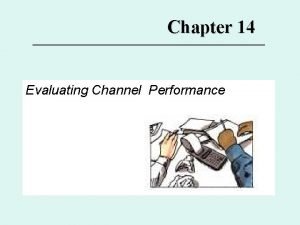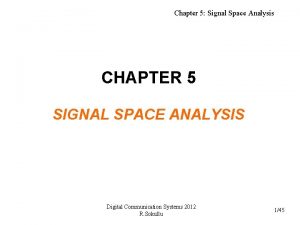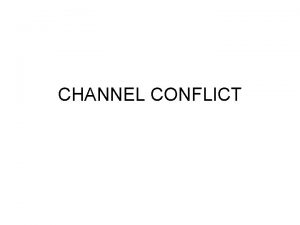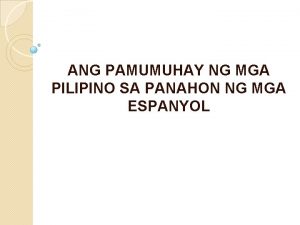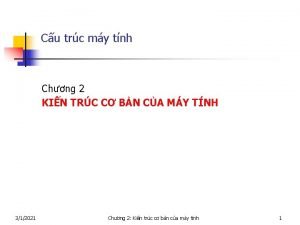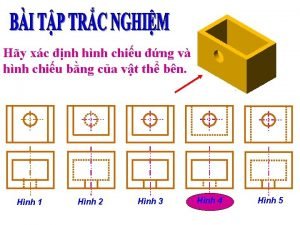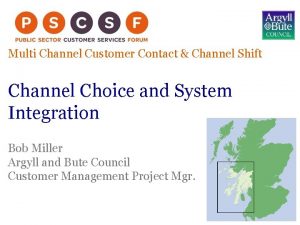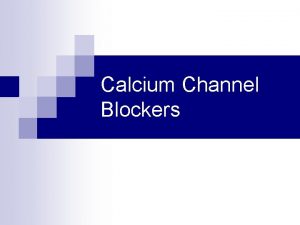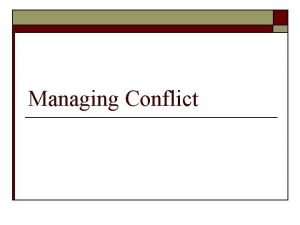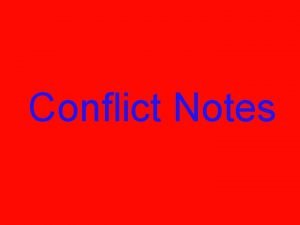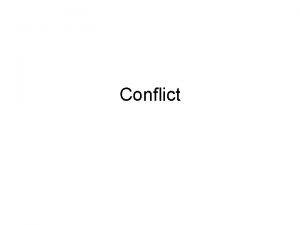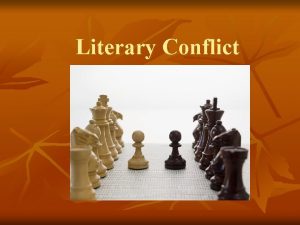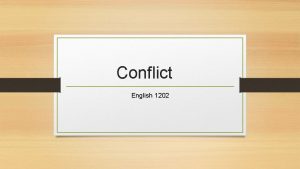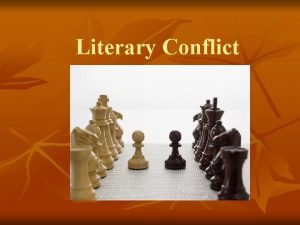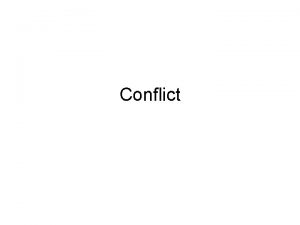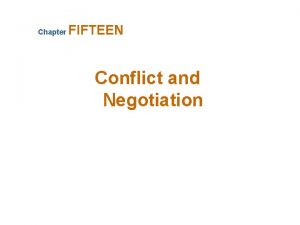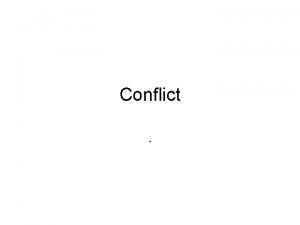CHANNEL CONFLICT Channel Conflict A channel conflict may





























- Slides: 29

CHANNEL CONFLICT

Channel Conflict • A channel conflict may be defined as “A situation in which one channel member perceives another channel member(s) to be engaged in behavior that prevents it from achieving its goals”. • Conflict is opposition, disagreement or discard among the organizations.

Channel Conflict • Conflict is not always undesirable. • It is needed to have positive effect as loopholes in the existing system can be plugged timely and performance can be maximized. • It can keep other channel members on their toes knowing that a decline in performance might lead to a change in the channel arrangements.

Types of conflict • Each channel member views the conflict, the relationship and the tensions differently. Following are the types of channel conflicts – • Latent conflict – The channel members may be unaware about the opposition. They do not fully sense the conflict. This is due to the separate or un-conflicting goals. • Perceived conflict – The channel members sense that some sort of opposition of perceptions, of interest, or of intensions exists. It is more psychological, i. e. two organizations can perceive that they are in disagreement but their individual members do not consider it as a very serious issue.

Types of conflict • Felt conflicts – When channel members not only perceive the opposition or disagreement but also feel it actually they are felt or affective conflicts. This needs to be sorted out at a early stage to avoid further consequences. • Manifest Conflict – If felt conflicts are not managed in time and properly, they can become manifest or overt conflicts and these conflicts stop the cooperation and understanding between two organizations and block the other from achieving its goals. • Functional Conflict – When channel members accept that there is opposition and disagreement but actually, this opposition will improve their relationship, it becomes functional conflict. It is common, obvious and sometimes desirable too due to the interdependence of channel members on each other.

Conflicts can also be classified as • • Vertical conflict Horizontal conflict Inter type conflict Multi Channel conflict

Vertical conflicts • Vertical conflicts occur due to the differences in goals and objectives, misunderstandings, and mainly due to the poor communication • Lack of role clarity and over dependence on the manufacturers. For e. g. Today the large retailers dominate the market and dictate the terms. Hence there are often conflicts between these giant retailers and the manufacturers.

• Wholesalers expect manufacturers to maintain the product quality and production schedules and expect retailers to market the products effectively. In turn, retailers and manufacturers expect wholesalers to provide coordination functional services. If they fail to conform each others expectations, channel conflict results.

Some common reasons for vertical conflict are • Dual distribution i. e. manufacturers may bypass intermediaries and sell directly to consumers and thus they compete with the intermediaries. • Over saturation, i. e. manufacturers permit too many intermediaries in a designated area that can restrict, reduce sales opportunities for individual dealer and ultimately shrink their profits.

• Partial treatment, i. e. manufacturers offer different services and margins to the different channels members even at same level or favor some members. • New channels, i. e. manufacturers develop and use innovative channels that create threat to establish channel participants.

• No or inadequate sales support and training to intermediaries from the manufacturers. • Irregular communication, non cooperation and rude behavior with the channel members.

• Stipulation of ordering in advance, high stock holding and dumping the stock at the intermediaries. • Delays in delivering the products or sometimes dispatching the products without confirmed order. • Refusal to replace or take back the goods damaged in transit. Non co-operation in replacement of faulty goods, repairing services, and installations.

• No co-operative advertisements. Manufacturers do not share any expenses of advertisements. • No or inadequate credit offered to the intermediaries. Margins / commissions are not sufficient and there is no periodic revision of commission and other terms

Conflicts due to the Intermediaries Actions • Intermediaries promote and sell more private labels than promoting the manufacturer’s brands. • Intermediaries encourage customers to switch to private labels / competitive products. • Intermediaries carry competing lines and give more showroom space.

• No support in the manufacturer’s promotional efforts. • Intermediaries fail to get the expected / promised efforts. • Intermediaries fail to collect payment from market in stipulated time.

• Intermediaries deliberately cut the prices to harm the manufacturers. • Intermediaries refuse to service and install manufacturer’s products. • No appropriate and timely market feedback and report to the manufacturers.

Horizontal conflicts • Horizontal conflicts are the conflicts between the channel members at the same level, i. e. two or more retailers, two or more franchisees etc. These conflicts can offer some positive benefits to the consumers. Competition or a price war between two dealers or retailers can be in favor of the consumers.

Reasons behind horizontal conflicts Price-off by one dealer / retailer can attract more customers of other retailers. • Aggressive advertising and pricing by one dealer can affect business of other dealers.

Reasons behind horizontal conflicts • Extra service offered by one dealer / retailer can attract customers of others. • Crossing the assigned territory and selling in other dealers / retailers / franchises area. • Unethical practices or malpractices of one dealer or retailer can affect other and spoil the brand image.

Inter Type conflict • Inter type conflict occurs when, the Intermediaries dealing in a particular product starts trading outside their normal product range. For example, now the supermarkets such as Foodworld also sell vegetables and fruits and thus compete with small retailers selling these products. Large retailers often offer a large variety and thus they compete with small but specialized retailers. This concept is called as “Scrambled Merchandising” where the retailers keep the merchandise lines that are outside their normal product range.

Multi-channel Conflict • Multi-channel conflict occurs when the manufacturer uses a dual distribution strategy, i. e. the manufacturer uses two or more channel arrangements to reach to the same market. • Manufacturers can sell directly through their exclusive showroom or outlets. This act can affect the business of other channels selling manufacturer’s brands.

Multi-channel Conflict • Manufacturers can bypass the wholesalers and sell directly to the large retailers. Conflict becomes more intense in this case as the large retailers can enjoy more customers and so the profit due to offering more variety and still economical prices, which is possible due to a volume purchase.

Resolving Channel Conflicts • Conflict is a natural phenomenon, which cannot be eliminated. In channel management, it is a inevitable as many individuals, institutions are involved and they are interdependent. Certain conflicts are constructive too. • The conflicts can be reduced and managed better to reduce the friction in the channel management. Various techniques can be used to resolve the conflicts. It is important to find out the root cause behind the conflict so that appropriate technique can be used to resolve the conflicts and lasting effect is possible.

Some techniques are as follows • Channel leadership – Many channel conflicts can be resolved through the effective channel leadership. Channel leader is able to reduce conflicts because he possesses the channel power. Channel power is the ability of one channel member to influence another member’s marketing decisions and goal achievement. It enables the leader to influence overall channel performance. The channel leader controls resources on which other members depend. Channel power can increase conflict and reduce cooperation if one channel member uses coercion to influence others. Manufacturers, wholesalers or even retailers can become the channel leaders. For example, producers like IBM, Ford can act as channel leaders because of their economic power.

• Adoption of Super ordinate goals – The channel members come to an agreement on the fundamental goal they are jointly seeking, whether it is survival, market share, high quality or customer satisfaction. • Exchange of persons between two or more channel levels – This helps in better understanding. It can reduce the misunderstanding and conflicts can be reduced substantially through this communication. Each will grow to appreciate the others point of view and carry more understanding when returning to their position.

• Co-Opt – It is an effort by one organization to win the support of the leaders of another organization by including them in advisory councils, board of directors so that they feel that their opinions are being heard. Co -optetion can reduce conflict provided both the parties compromise some or the other issues in order to win the support of the other side.

• Joint membership in and between trade associations – Such associations bring all participants under one roof for more exposure to the public and to improve relations with each other by understanding their problems. • Diplomacy – Diplomacy takes pace when each side sends a person or a group to meet with their counterpart from the other side to resolve the conflict. It makes sense to assign diplomats to work more or less continuously with each other to avoid the conflicts.

• Third-Party Mechanisms – When conflict is chronic, and the above mentioned techniques are ineffective, both the parties may have to resort to third parties, which are not involved or not the part of the existing channel. – Arbitration – In this method, the two parties agree to present their arguments to a third party and accept arbitration decisions.

Mediation – Mediation implies resorting to a neutral third party who brings skills in conciliating the interests of the two parties. Mediation is the process whereby a third party attempts to secure settlement of a dispute by persuading the parties either to continue their negotiations or to consider procedural recommendations that mediator may make. Mediator has a fresh view of the situation and may perceive opportunities that insiders cannot. Effective mediation succeeds in clarifying facts and issues. Mediators help the parties to set up their own decisions whereas in arbitration it can be compulsory.
 Hci patterns may or may not include code for implementation
Hci patterns may or may not include code for implementation Channel member performance audits
Channel member performance audits Conversion of continuous awgn channel to vector channel
Conversion of continuous awgn channel to vector channel Determine id
Determine id Multi channel retailing definition
Multi channel retailing definition Channel conflict definition
Channel conflict definition A struggle between a character and an outside force
A struggle between a character and an outside force What is conflict and conflict resolution?
What is conflict and conflict resolution? External conflict definition
External conflict definition January february march april
January february march april Explain how class evidence can have probative value
Explain how class evidence can have probative value Bsu buguias campus
Bsu buguias campus Liza may
Liza may February march april may june july
February march april may june july Dr hila may
Dr hila may Is may in spring or summer
Is may in spring or summer Exercise may alcohol consumption
Exercise may alcohol consumption Ang mga kalahok sa polo y servicio ay tinatawag na
Ang mga kalahok sa polo y servicio ay tinatawag na Third of may 1808 meaning
Third of may 1808 meaning Eula may to kill a mockingbird
Eula may to kill a mockingbird Pananalig at pagmamahal sa diyos paninindigan sa kabutihan
Pananalig at pagmamahal sa diyos paninindigan sa kabutihan Bộ nhớ máy tính
Bộ nhớ máy tính Có mấy loại mặt cắt
Có mấy loại mặt cắt May your spirit
May your spirit Seek the lord while he may be found
Seek the lord while he may be found Ang isdang ito ay nangangailangan ng bakod
Ang isdang ito ay nangangailangan ng bakod Not fdic insured may lose value
Not fdic insured may lose value Ano ang apat na uri
Ano ang apat na uri Ang pagtuturo ng pagbasa
Ang pagtuturo ng pagbasa Tenth may dawned bright and clear
Tenth may dawned bright and clear

